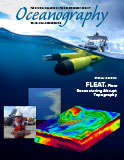Article Abstract
The near-surface response to underwater topography changes is of great importance for navigational safety near regions of strong bathymetry gradients, such as around the islands of the Republic of Palau. There, mean underwater inclines can be as much as 25% of the horizontal distance, leading to a depth change of up to 85% within 26 km. Many processes associated with oceanic flows produce surface manifestations that are readily imaged from afar by synthetic aperture radar (SAR) or ship-based X-band Doppler marine radar (DMR). SAR and DMR imagery complement each other, with SAR providing a large-scale snapshot of the region on the order of 50 km or more and the DMR offering a mobile smaller-scale look at a particular area on the order of about 6 km with the ability to measure near-surface currents (1–5 m depth) in the vicinity of the ship. In this paper, we discuss the results from an analysis of thousands of DMR images around the islands of Palau. Three types of ocean surface features were identified: internal waves, surface slicks, and convergent fronts. Internal waves and convergent fronts are directly influenced by abrupt topography, and surface slicks can aid in the surface feature imaging process if their shapes are modulated by spatially varying surface currents. These ocean surface features are examined with respect to their associations with changes in the seafloor thousands of meters beneath them.

